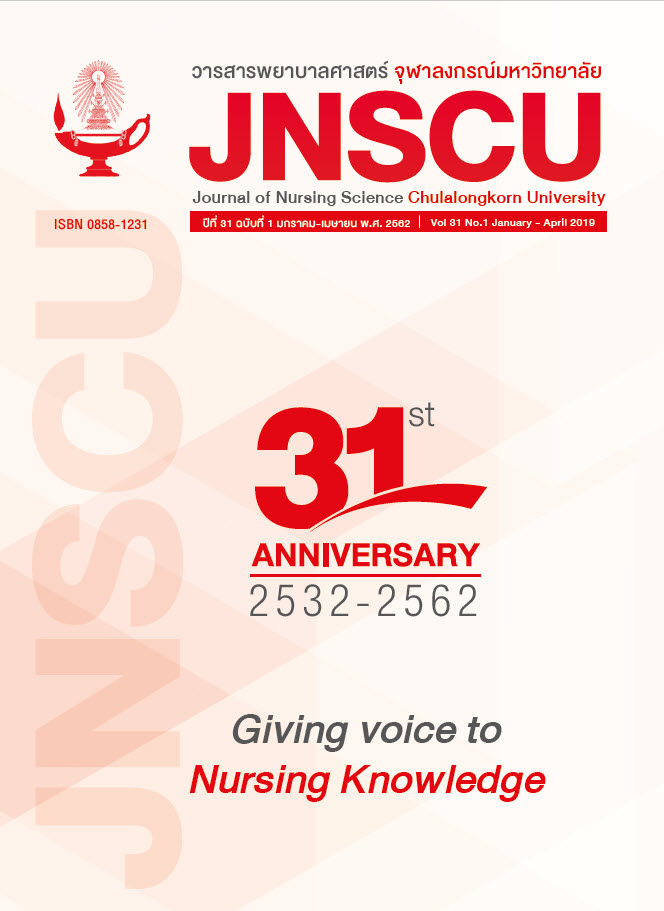“Continuing life” Of Adolescents with Cancer Relapse Receiving Palliative Care
Keywords:
Life, Adolescent Patients, Cancer Relapse, Palliative careAbstract
Objective: To describe the living of patients with cancer relapse who were received palliative care.
Research Design: Qualitative research using Edmund Husserl phenomenology approach.
Research Methodology: The key informants selected with purposive sampling were adolescents patients (boys and girls), diagnosed by doctors which they had leukemia lymphoma and central nervous system tumors. They were treated with chemotherapy for at least 1 year, perceived and received palliative care for at least 6 months. Data were collected by in-depth interviews based on means of Colaizzi until the information was saturated. A total of the key informants were 9 patients.
Results: “Continuing life” is one of the main points from this study by dividing into three important areas: 1) Life different from others: It is a life changing because of sickness, so they do not have to stay in the same age. 2) Life with happiness: It is to be happy continue to live with cancer illnesses and 3) Life with encouragement and support for self and family: By seeking a person to hold on to the encouragement of living.
Conclusion: This result showed that health professionals have understood aspects of the palliative care of relapse patients during recurrent-cancer treatment. The data can be used as a guideline for assessing the problem and needs for palliative care nursing interventions for those patients precisely and appropriately.
References
Cancer.gov [Internet].The U.S.A: ChildhoodCancer Survivor Study: An Overview;c2016- [updated 2018Jan31;cited 2018Dec 6] Available from:http://www.cancer.gov.
Warner EL,Kent EE,TrevinoKM,Parsons HM,Zebrack BJ, Kirchhoff AC. Social wellbeing among adolescents and youngadults withcancer:asystematicreview.Cancer 2016; 122(7): 1029-1037.
Erickson JM, MacPherson CF, Ameringer S,Baggott C, Linder L, Stegenga K.Symptoms and symptom clusters inadolescentsreceivingcancer treatment:a review of the literature. International
Journal of Nursing Studies 2013; 50(6):847-869.
Anshushaug M, Gynnild MA,KaasaS,Kvikstad,A, Grønberg BH. Characterization ofpatients receiving palliativechemo-andradiotherapy during end of life at aregional cancer center in Norway. Acta
Oncologica 2015; 54(3): 395-402.
DaviesB,SehringSA,PartridgeJC, CooperBA,Hughes A, Philp JC, et al. Barriers topalliativecareforchildren: perceptionsof pediatric health care providers.Pediatrics 2008; 121(2):282-288.
De GS, ArandaS.Living withhopeand fear-theuncertainty of childhood cancer afterrelapse. Cancer nursing 2008; 31(4):292-301.
Arruda CM,PerinaE,Santos M.ExperiencesofBrazilianchildrenand family caregiversfacingtherecurrenceofcancer.EuropeanJournalof Oncology Nursing2015;19(5):458-464.
TreenaiS, ChaiyawatW,Yunibhand J.RealizingBeing a Leukemic Patient: the StartingPoint of Returning to Normality in ThaiAdolescents.Journalof HealthResearch2015; 29(1): 7-13. (in Thai)
Manen MV. Phenomenology of practice:Meaning-givingmethodsin phenomenological research and writing.1thed.New York: Routledge; 2014.
Edward, KL, Welch T. The extension ofColaizzi’smethod of phenomenological
enquiry. Contemporary Nurse 2011; 39(2):163-171.
Lincon,Y.S.,& Guba,E. G. NaturalisticInquiry:SAGE Publications. (1985 ).
Daniel LC, Brumley LD, Schwart LA. Fatiguein adolescents with cancer comparedtohealthyadolescents.Pediatric blood& cancer 2013; 60(11):1902-1907.
WoodgateRL.Feelingstates:anew approachto understanding how children andadolescents with cancer experiencesymptoms. Cancer Nursing 2008; 31(3):229-238.
Wicks L, Mitchell A. The adolescent cancerexperience: lossof control and benefitfinding.Europeanjournalofcancercare2010; 19(6): 778-785.
Griffiths M,SchweitzerR,YatesP. Childhoodexperiencesofcancer:aninterpretativephenomenological analysis approach.Journal of Pediatric Oncology Nursing2011; 28(2): 83-92.
Vlachioti E, Matziou V, Perdikaris P, MitsiouM, Stylianou C, Tsoumakas K, et al.Assessmentof qualityof lifeofchildrenand adolescents with cancer duringtheir treatment. Japanese journal ofclinical oncology 2016; 46(5): 453-461.
Downloads
Published
Issue
Section
License
ลิขสิทธิ์ของบทความที่ตีพิมพ์เป็นของวารสารพยาบาลศาสตร์ จุฬาลงกรณ์มหาวิทยาลัย ทั้งฉบับตีพิมพ์เป็นรูปเล่มและเอกสารออนไลน์



